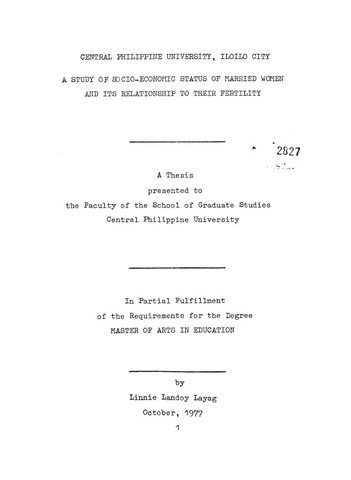Ipakita ang simpleng tala ng item
A study of socio-economic status of married women and its relationship to their fertility
| dc.contributor.adviser | Ruiz, Macario B. | |
| dc.contributor.author | Layag, Linnie Landoy | |
| dc.date.accessioned | 2021-10-13T06:59:18Z | |
| dc.date.available | 2021-10-13T06:59:18Z | |
| dc.date.issued | 1977 | |
| dc.identifier.citation | Layag, L. L. (1977). A study of socio-economic status of married women and its relationship to their fertility (Unpublished Master’s thesis). Central Philippine University, Jaro, Iloilo City. | en_US |
| dc.identifier.uri | https://hdl.handle.net/20.500.12852/1549 | |
| dc.description | Introduction and statement of the problem | en_US |
| dc.description.abstract | Statement of the Problem. In general the main problem of this study was to find out whether socio-economic status and community characteristics are associated with fertility. The factors which form the total socio-economic status like educational attainment, income, occupation and professional status were each also taken into account as they related individually to fertility. Incidentally, this study also aimed to present a profile of the respondents with reference to their socio-economic status in general. More specifically, the following questions were to be answered. 1. Profile of the respondents a. Generally, from what socio-economic level do most of the respondents cone? b. What is the average monthly family income? c. What is the average educational attainment of the respondents in terms of years of schooling? d. Are there differences in the number of pregnancies of the respondents 1. in the towns, the barrios, and the city? 2. with varying educational attainment? 3. with varying monthly family income? 4. with different socio-economic status? 5. Whose husbands belong to different occupational groups? 2. Relationship a. Is there relationship between fertility and place of residence? b. Is there relationship between fertility and types of community according to major source of livelihood? c. Is there relationship between fertility and 1. socio-economic status? 2. joint educational attainment of husband and wife as represented by their combined scores? 3. monthly family income? 4. joint professional status of husband and wife as represented by their combined scores? 5. Other SES indicators like types of residence, appliances in the home, subscription to books and magazines, and membership in civic and social organizations? | en_US |
| dc.format.extent | 167 leaves | en_US |
| dc.language.iso | en | en_US |
| dc.subject.ddc | GSL Theses 378.242 L451 | en_US |
| dc.subject.lcsh | Married women | en_US |
| dc.subject.lcsh | Married women--Social conditions | en_US |
| dc.subject.lcsh | Fertility, Human--Social aspects | en_US |
| dc.subject.lcsh | Fertility, Human--Economic aspects | en_US |
| dc.subject.lcsh | Social status | en_US |
| dc.subject.lcsh | Fertility | en_US |
| dc.title | A study of socio-economic status of married women and its relationship to their fertility | en_US |
| dc.type | Thesis | en_US |
| dc.description.bibliographicalreferences | Includes bibliographical references | en_US |
| dc.contributor.chair | Ruiz, Macario B. | |
| dc.contributor.committeemember | Griño, Eliza U. | |
| dc.contributor.committeemember | Traviña, Miriam M. | |
| dc.contributor.committeemember | Herradura, Elma S. | |
| dc.contributor.department | School of Graduate Studies | en_US |
| dc.description.degree | Master of Arts in Education | en_US |
| local.relation.associatedcontent | https://repository.cpu.edu.ph/handle/20.500.12852/2495 Journal article published in Southeast Asia Journal | en |


